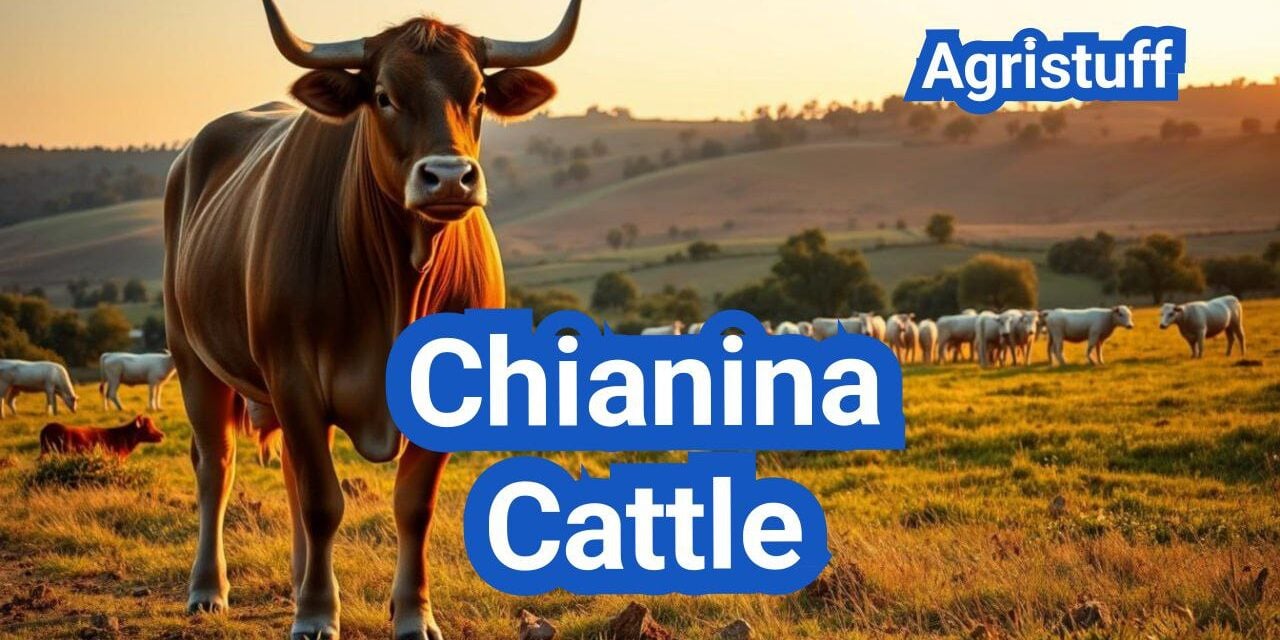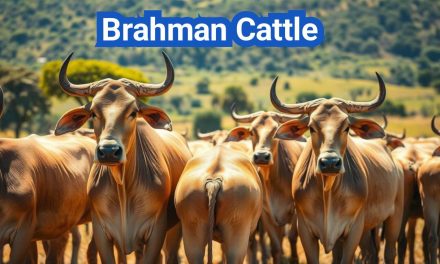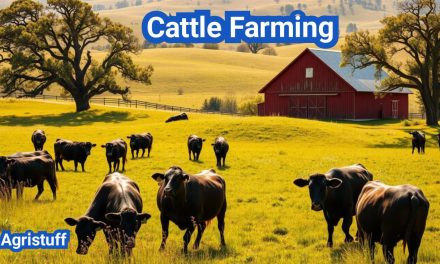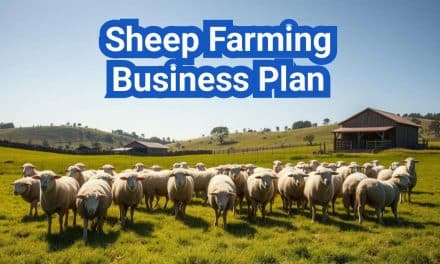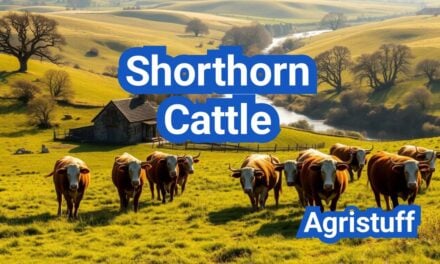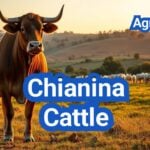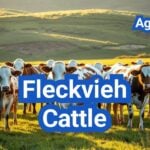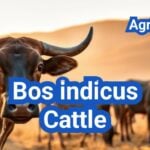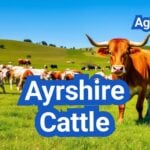The Chianina breed has a rich history, originating in Italy and known for its impressive size and white color.
This ancient breed has been gaining attention in the U.S. beef industry due to its unique characteristics and potential for growth.
With its origins dating back centuries, the Chianina breed has evolved to become a significant player in the global beef market.
Key Takeaways
- The Chianina breed is known for its large size and white color.
- Originating in Italy, the breed has a rich history.
- The Chianina breed is gaining attention in the U.S. beef industry.
- Its unique characteristics make it a potential player in the global beef market.
- The breed’s history and characteristics are essential to understanding its prospects.
The Ancient Origins of Chianina Cattle
Originating in Italy, Chianina cattle have a storied past that spans centuries, with their history deeply intertwined with the country’s agricultural heritage. The breed’s name is derived from the Chiana Valley in Tuscany, where it has been bred for centuries.
Historical Significance in Italy
Chianina cattle have played a significant role in Italian agriculture for over 2,000 years, serving not only as a source of labor but also as a symbol of wealth and status. The breed’s impressive size and strength made it an ideal draft animal, capable of pulling heavy loads and working in challenging conditions.
The historical significance of Chianina cattle is further underscored by their presence in Italian art and literature throughout the centuries. They have been depicted in various works of art, highlighting their importance in the country’s cultural heritage.
Evolution from Draft Animals to Beef Cattle
Over time, the primary use of Chianina cattle shifted from draft animals to beef production. This transition was driven by changes in agricultural practices and the growing demand for high-quality beef. Today, Chianina cattle are renowned for their exceptional meat production capabilities, with their beef prized for its tenderness and flavor.
| Historical Period | Primary Use of Chianina Cattle | Notable Characteristics |
|---|---|---|
| Ancient Times | Draft Animals | Strength, Size |
| Middle Ages | Draft Animals, Meat Production | Endurance, Muscling |
| Modern Era | Beef Production | Meat Quality, Growth Rate |
The evolution of Chianina cattle from draft animals to a premier beef breed reflects the adaptability and resilience of the breed, as well as the changing needs of agriculture and food production.
Chianina Cattle: The World’s Largest Cattle Breed

The Chianina breed is distinguished by its extraordinary size, with mature bulls reaching heights of up to six feet at the shoulder. This characteristic, combined with their muscular build and white coat, makes them one of the most recognizable cattle breeds worldwide.
Distinctive Physical Features
Chianina cattle are known for their large frame, robust bone structure, and muscular development. Their coat is typically white, although they may be born with a slightly different coloration that fades as they mature. The breed’s physical characteristics are not limited to size; they also possess a distinctive head shape and a robust constitution.
Key Physical Attributes:
- Large frame and muscular build
- White coat color
- Robust bone structure
Size and Weight Specifications
Mature Chianina bulls can weigh between 2,200 to 3,000 pounds, with some exceptional individuals reaching even higher weights. Their height at the shoulder can range from 5.5 to 6 feet, making them one of the tallest cattle breeds globally.
| Category | Height (feet) | Weight (pounds) |
|---|---|---|
| Mature Bulls | 5.5 – 6 | 2,200 – 3,000 |
| Mature Cows | 4.5 – 5.5 | 1,500 – 2,000 |
Breed Standards and Classification
The American Chianina Association maintains the breed standards for Chianina cattle in the United States. According to these standards, Chianina cattle are classified based on their percentage of Chianina breeding. The breed is known for its purity and is often used in crossbreeding programs to improve size and growth rate in other breeds.
“The Chianina breed has been instrumental in enhancing the genetic potential of various cattle breeds through crossbreeding, thanks to its exceptional size and growth characteristics.”
The classification system helps in identifying the purity and potential of Chianina cattle for breeding purposes, ensuring that the breed maintains its distinctive characteristics while being utilized effectively in various cattle production systems.
How to Measure and Evaluate Frame Score in Chianina
Evaluating the frame score of Chianina cattle is crucial for determining their production potential. Frame score is an indicator of the cattle’s skeletal size, which is a critical factor in determining their growth rate and mature weight.
Frame Scoring Methodology
Frame scoring in Chianina cattle involves measuring the height of the cattle at specific points to estimate their skeletal size. The most common method is to measure the hip height, which is the distance from the ground to the hip bone. This measurement is then used to estimate the frame score, typically on a scale of 1 to 10, with higher scores indicating larger frames.
Accurate measurement is critical for obtaining a reliable frame score. The cattle should be standing on a level surface, and the measurement should be taken with a calibrated measuring device.
Interpreting Frame Scores for Production Potential
The frame score of Chianina cattle is a valuable indicator of their production potential. Cattle with higher frame scores tend to have faster growth rates and reach maturity later, which can impact their market value and production efficiency.
| Frame Score | Growth Rate | Mature Weight |
|---|---|---|
| 3-4 | Slow | Lower |
| 5-6 | Moderate | Average |
| 7-8 | Fast | Higher |
Comparing Chianina Frame to Other Beef Breeds
Chianina cattle are known for their large frame size compared to other beef breeds. When comparing frame scores across breeds, it’s essential to consider the breed standards and the specific measurement techniques used.
For example, Chianina cattle typically have a higher average frame score than Angus or Hereford cattle. This larger frame size contributes to their rapid growth rate and high mature weight.
Understanding these differences is crucial for producers who are considering crossbreeding or selecting breeds for specific production goals.
Monitoring Growth Rate and Development Patterns

Monitoring the growth of Chianina cattle from birth to maturity is essential for achieving optimal production outcomes. Effective growth monitoring enables producers to make informed decisions about nutrition, breeding, and overall management strategies.
Birth to Weaning Growth Metrics
The growth rate of Chianina cattle from birth to weaning is a critical period that sets the stage for future development. Key metrics during this period include:
- Birth weight: A crucial indicator of potential growth rate and development.
- Average daily gain (ADG): Measuring the rate of weight gain from birth to weaning.
- Weaning weight: A significant factor in determining the overall growth trajectory.
Optimizing growth during this period involves ensuring adequate nutrition for both the dam and calf. Research has shown that calves with higher weaning weights tend to have better overall performance in subsequent growth stages.
Post-Weaning Development Strategies
After weaning, Chianina cattle require careful management to optimize their growth potential. Strategies include:
- Nutritional programs tailored to the age and size of the cattle.
- Health management protocols to prevent disease and promote overall well-being.
- Monitoring and adjusting growth rates according to production goals.
Proper nutrition is particularly important during the post-weaning phase, as it directly impacts the cattle’s ability to achieve their genetic potential for growth.
Maturity Timeline and Weight Gain Efficiency
Chianina cattle are known for their late maturity, which allows for extended periods of growth. Understanding the maturity timeline is crucial for:
- Predicting when cattle will reach market weight.
- Optimizing feeding strategies to maximize weight gain efficiency.
- Managing the overall production cycle to achieve the best economic outcomes.
As noted by experts, “Chianina cattle continue to grow and develop until they are about 24 months of age, making them one of the later-maturing breeds.”
This late maturity characteristic allows producers to take advantage of compensatory gain strategies, potentially reducing feed costs.
By closely monitoring growth rates and development patterns, producers can make informed decisions that enhance the overall efficiency and profitability of their Chianina cattle operations.
Managing Chianina Cattle Temperament
Managing the temperament of Chianina cattle is essential for farmers to maximize their potential and maintain a safe working environment. Chianina cattle are known for their large size and unique temperament, which can impact their handling and overall productivity.
Understanding Behavioral Traits
Chianina cattle exhibit specific behavioral traits that are shaped by their breed characteristics and environmental factors. Understanding these traits is crucial for effective handling and management. Their large size can sometimes be intimidating, but it’s essential to recognize that their temperament is generally docile.
However, like any cattle breed, individual personalities can vary. Some Chianina cattle may be more aggressive or skittish due to factors such as genetics, handling practices, and environmental conditions. Observing and understanding these behavioral nuances is key to developing appropriate handling strategies.
Handling Techniques for Large-Framed Cattle
Handling large-framed cattle like Chianina requires specific techniques to ensure both the animal’s and handler’s safety. It’s crucial to move calmly and deliberately around the cattle, avoiding sudden movements that could startle them. Using appropriate handling facilities designed for large cattle can also significantly reduce the risk of injury to both humans and animals.
Training handlers in low-stress handling techniques can improve the overall management of Chianina cattle. This includes understanding cattle behavior, using appropriate handling equipment, and implementing facility designs that minimize stress and promote safe handling practices.
- Move calmly and deliberately around the cattle.
- Use appropriate handling facilities.
- Train handlers in low-stress handling techniques.
By understanding and managing the temperament of Chianina cattle, farmers can enhance their production efficiency and maintain a safe working environment. Effective temperament management is a critical component of successful cattle production.
How to Formulate Nutrition Plans for Optimal Growth

Formulating an effective nutrition plan is crucial for optimizing the growth of Chianina cattle. Nutrition plays a critical role in the development and productivity of beef cattle, and Chianina, being one of the largest and most muscular breeds, have specific dietary needs that must be met to achieve their full potential.
A well-designed nutrition plan not only enhances growth rate and efficiency but also improves overall health and reduces the risk of nutritional deficiencies. As stated by the National Research Council, “Nutrient requirements for beef cattle are influenced by factors such as age, sex, breed, and stage of production.”
“Nutrient requirements for beef cattle are influenced by factors such as age, sex, breed, and stage of production.” – National Research Council
Feed Conversion Efficiency Optimization
Feed conversion efficiency is a critical factor in the profitability of beef cattle production. It refers to the ability of cattle to convert feed into body weight gain. Optimizing feed conversion efficiency involves selecting cattle with genetic potential for growth, providing a diet that meets their nutritional needs, and ensuring that feeding practices minimize waste.
Key strategies for optimizing feed conversion efficiency include:
- Selecting high-growth genetics
- Providing a nutrient-dense diet
- Implementing efficient feeding practices
Diet Formulation for Different Growth Stages
The nutritional requirements of Chianina cattle vary across different growth stages. For instance, calves require a diet rich in protein and energy to support rapid growth and development, while mature cattle may require less energy but more maintenance nutrients.
Diet formulation should consider the following stages:
- Pre-weaning
- Post-weaning
- Backgrounding
- Finishing
Supplementation Strategies for Performance
Supplementation is often necessary to ensure that Chianina cattle receive all the necessary nutrients, particularly when grazing on pasture or when the diet is based on forages that may be nutrient-deficient.
Effective supplementation strategies involve:
- Identifying nutrient deficiencies
- Selecting appropriate supplements
- Monitoring cattle response to supplementation
By formulating nutrition plans that are tailored to the specific needs of Chianina cattle at different growth stages and optimizing feed conversion efficiency, producers can enhance the performance and profitability of their operations.
Selecting Chianina Cattle for Breeding Programs

Breeding programs that incorporate Chianina cattle require careful consideration of genetic traits and performance metrics. The success of a breeding program depends on the selection of high-quality breeding stock that can pass on desirable characteristics to their offspring.
Evaluation Criteria for Breeding Stock
When evaluating Chianina cattle for breeding, several key factors must be considered. These include the animal’s pedigree, physical characteristics, growth rate, and fertility. A thorough evaluation of these traits helps ensure that the selected breeding stock will produce offspring with improved performance and quality.
The pedigree of a Chianina animal provides valuable information about its ancestry and potential genetic traits. Producers should look for animals with a strong pedigree that includes lineage known for desirable characteristics such as rapid growth rate, muscularity, and fertility.
Genetic Traits to Prioritize
Certain genetic traits are particularly important when selecting Chianina cattle for breeding. These include traits related to growth rate, muscling, and reproductive efficiency. By prioritizing these traits, producers can improve the overall productivity and quality of their herd.
- Growth rate: Animals with a high growth rate are more efficient and can reach market weight more quickly.
- Muscling: Well-muscled animals produce higher-quality beef and are more desirable for many markets.
- Reproductive efficiency: Animals with good reproductive traits are more likely to produce viable offspring, ensuring the long-term sustainability of the breeding program.
Performance Testing and Data Analysis
Performance testing is a critical component of any breeding program. By collecting and analyzing data on the performance of individual animals, producers can make informed decisions about which animals to retain for breeding and which to market.
| Trait | Measurement | Importance |
|---|---|---|
| Growth Rate | Average Daily Gain (ADG) | High |
| Muscling | Ribeye Area | High |
| Fertility | Pregnancy Rate | High |
Data analysis plays a crucial role in interpreting the results of performance testing. By using statistical methods to analyze the data, producers can identify trends and patterns that may not be immediately apparent. This information can then be used to refine the breeding program and make more informed selection decisions.
Implementing Crossbreeding Programs with Chianina

Crossbreeding with Chianina cattle offers a promising avenue for producers looking to capitalize on hybrid vigor benefits. By combining the genetic strengths of Chianina with other breeds, producers can create cattle that excel in growth rate, carcass quality, and environmental adaptability.
Designing Effective Crossbreeding Systems
To design an effective crossbreeding system, producers must first identify their production goals and the traits they wish to improve. This involves selecting breeds that complement the Chianina’s strengths while mitigating its weaknesses. For instance, crossing Chianina with breeds known for their marbling ability can enhance the overall quality of the beef produced.
ChiAngus and Other Successful Composite Breeds
One notable example of a successful composite breed is the ChiAngus, a cross between Chianina and Angus cattle. The ChiAngus combines the muscularity and growth rate of Chianina with the marbling and carcass quality of Angus, resulting in a highly marketable product.
Maximizing Hybrid Vigor Benefits
Hybrid vigor, or heterosis, is a key benefit of crossbreeding programs. It refers to the phenomenon where the offspring of two different breeds exhibit superior traits compared to either parent. To maximize hybrid vigor, producers should focus on selecting diverse breeds that are known to produce vigorous offspring when crossed.
The benefits of hybrid vigor can be seen in improved growth rates, increased fertility, and enhanced survival rates among crossbred cattle. By leveraging these benefits, producers can improve the overall efficiency and profitability of their operations.
| Breed Combination | Improved Traits | Production Benefits |
|---|---|---|
| Chianina x Angus (ChiAngus) | Muscularity, Marbling | High-quality beef, Improved marketability |
| Chianina x Hereford | Growth Rate, Hardiness | Increased efficiency, Better adaptability |
| Chianina x Simmental | Muscle Mass, Fertility | Enhanced growth, Improved reproductive performance |
How to Prepare Chianina Cattle for Show Competitions
Preparing Chianina cattle for show competitions requires a comprehensive approach that includes careful selection, meticulous development, and precise presentation techniques. The process begins long before the show day and involves a deep understanding of the breed’s characteristics and the competition’s judging criteria.
Show Cattle Selection and Development
The first step in preparing Chianina cattle for show competitions is selecting animals with the potential to excel. This involves evaluating the cattle’s conformation, musculature, and overall breed characteristics. Key selection criteria include a strong skeletal structure, well-developed musculature, and a balanced, proportional body.
Once the cattle are selected, a development program tailored to their specific needs is essential. This program should include a nutritionally balanced diet that supports optimal growth and development. Regular exercise and health management practices are also crucial to ensure the cattle are in top condition for the show.
Conditioning and Presentation Techniques
Conditioning Chianina cattle for show involves more than just feeding; it requires a strategic approach to enhance their appearance and overall presentation. This includes meticulous grooming practices such as regular clipping, washing, and conditioning to highlight the animal’s natural attributes.
Presentation techniques are equally important. Handlers should be trained to present the cattle confidently and professionally, showcasing their best features to the judges. This includes proper fitting and training to ensure the cattle are comfortable and responsive to handling during the show.
Show Ring Strategies and Handling
Success in the show ring depends not only on the quality of the cattle but also on the handler’s ability to present them effectively. Show ring strategies include understanding the judging criteria, positioning the cattle to their best advantage, and being prepared to answer questions about the animal’s breeding, history, and care.
Effective handling is critical, as it directly impacts the cattle’s presentation and the handler’s ability to showcase their strengths. Handlers should be calm, confident, and knowledgeable about the cattle they are presenting.
| Aspect | Description | Importance Level |
|---|---|---|
| Selection Criteria | Conformation, Musculature, Breed Characteristics | High |
| Development Program | Nutritional Diet, Exercise, Health Management | High |
| Grooming Practices | Clipping, Washing, Conditioning | Medium |
| Presentation Techniques | Fitting, Training, Handling | High |
| Show Ring Strategies | Judging Criteria, Positioning, Knowledge | High |
Utilizing Chianina Bulls as Terminal Sires

Incorporating Chianina bulls into a terminal crossing system can significantly enhance the efficiency of beef production. Terminal sires play a crucial role in beef cattle production, as they are used to produce market animals that are then sent to slaughter. The Chianina breed, known for its rapid growth rate and muscularity, is an ideal candidate for terminal sire programs.
Terminal Crossing System Design
Designing an effective terminal crossing system involves selecting breeds that complement the maternal genetics of the cow herd. Chianina bulls are often used as terminal sires due to their ability to sire fast-growing, heavy-muscled calves. When designing a terminal crossing system, producers should consider factors such as breed complementarity, heterosis, and the production goals of their operation.
A well-designed terminal crossing system can capitalize on the strengths of the Chianina breed, such as their exceptional growth rate and carcass quality. By crossing Chianina bulls with cows of another breed, producers can leverage hybrid vigor to produce calves with improved growth and carcass traits.
Expected Progeny Differences for Terminal Traits
Expected Progeny Differences (EPDs) are a valuable tool for selecting terminal sires. EPDs provide estimates of an animal’s genetic merit for various traits, including growth rate, carcass quality, and calving ease. When selecting Chianina bulls for use as terminal sires, producers should focus on EPDs for terminal traits such as yearling weight and carcass weight.
By using EPDs, producers can make informed decisions about which bulls to use in their terminal crossing program, ultimately improving the efficiency and profitability of their operation. For instance, selecting bulls with high EPDs for growth traits can lead to faster-growing calves that are more efficient to produce.
Managing Calving Ease Concerns
One potential concern when using Chianina bulls as terminal sires is calving ease. Chianina cattle are known for their large size and muscularity, which can sometimes lead to calving difficulties. To manage calving ease concerns, producers should select bulls with favorable EPDs for calving ease and consider the pelvic area of the heifers or cows being bred.
Additionally, producers can implement management strategies such as monitoring heifers closely during calving and having a plan in place for assisted calving if necessary. By taking a proactive approach to managing calving ease, producers can minimize the risks associated with using Chianina bulls as terminal sires.
Maximizing Carcass Traits and Beef Quality

To capitalize on the premium market, Chianina cattle farmers must focus on enhancing carcass traits and beef quality. The breed is known for its exceptional growth rate and muscularity, which, when managed correctly, can result in high-quality beef products.
Meat Yield and Quality Grade Potential
Chianina cattle are capable of producing carcasses with high meat yield and quality grade potential. Proper nutrition and management practices are crucial to achieving these traits. Factors such as feed conversion efficiency, growth rate, and fat deposition patterns significantly influence the final product quality.
The American Chianina Association provides guidelines for producers to optimize their cattle’s genetic potential. By adhering to these guidelines, farmers can improve the yield and quality of their beef, making it more competitive in the market.
Tenderness and Flavor Profile Development
Tenderness and flavor profile are critical components of beef quality. Chianina beef is known for its tenderness due to the breed’s muscular structure and low fat content. Proper aging and handling techniques can further enhance these characteristics, resulting in a more palatable product for consumers.
Research has shown that factors such as animal genetics, nutrition, and pre-slaughter handling can significantly impact the tenderness and flavor of beef. By controlling these factors, producers can develop a consistent and high-quality product.
Marketing Strategies for Chianina Beef Products
Effective marketing strategies are essential for differentiating Chianina beef products in a competitive market. Highlighting the breed’s unique characteristics, such as its lean meat and superior tenderness, can attract premium prices.
- Emphasize the breed’s heritage and the quality of the beef.
- Utilize branding to convey the unique selling points of Chianina beef.
- Engage with consumers through educational marketing about the benefits of Chianina beef.
By implementing these strategies, producers and marketers can capitalize on the growing demand for high-quality, specialty beef products.
Working with the American Chianina Association

The American Chianina Association plays a pivotal role in the development and promotion of Chianina cattle in the United States. By providing various resources and services, the association supports breeders in maintaining the breed’s integrity and enhancing its potential.
Registration and Performance Programs
The American Chianina Association offers comprehensive registration and performance programs for Chianina cattle breeders. These programs are designed to:
- Maintain accurate breed records
- Evaluate cattle performance
- Provide breeders with valuable data for selection decisions
Registration involves documenting the pedigree and ownership of cattle, ensuring the breed’s purity and traceability. Performance programs, on the other hand, assess traits such as growth rate, carcass quality, and reproductive efficiency.
Breed Promotion and Development Resources
The association is committed to promoting the Chianina breed through various initiatives and resources. These include:
- Educational materials and workshops
- Marketing campaigns to increase breed visibility
- Networking opportunities for breeders
By providing these resources, the American Chianina Association helps breeders stay informed about best practices and emerging trends in Chianina cattle production.
Accessing Genetic Evaluation Services
Genetic evaluation is a critical component of any breeding program, and the American Chianina Association offers advanced genetic evaluation services. These services enable breeders to:
- Identify genetically superior animals
- Make informed breeding decisions
- Improve the overall quality of their herd
The association’s genetic evaluation services are based on comprehensive data analysis, incorporating information on various traits such as growth rate, carcass quality, and reproductive performance.
In conclusion, the American Chianina Association provides essential support to Chianina cattle breeders through its registration and performance programs, breed promotion resources, and genetic evaluation services. By leveraging these resources, breeders can enhance their breeding programs, improve cattle quality, and contribute to the ongoing development of the Chianina breed.
How to Establish a Chianina Herd in the U.S.

The process of setting up a Chianina cattle herd involves several critical steps, from sourcing the right breeding stock to designing appropriate facilities. Establishing a successful Chianina operation requires a thorough understanding of the breed’s characteristics, growth patterns, and market demand.
Sourcing Quality Foundation Breeding Stock
Sourcing high-quality foundation breeding stock is crucial for the success of a Chianina herd. This involves identifying reputable breeders who can provide cattle that meet the breed standards and have desirable genetic traits.
- Research and visit reputable Chianina breeders to inspect their cattle.
- Evaluate the genetic lineage and performance records of potential breeding stock.
- Consider purchasing cattle that have been performance-tested or have progeny with proven track records.
Facility Requirements for Large-Framed Cattle
Chianina cattle are known for their large frame size, which necessitates specific facility requirements to ensure their health and well-being.
| Facility Component | Requirements for Chianina Cattle |
|---|---|
| Paddock Space | Minimum of 1 acre per 2-3 head to allow for adequate movement |
| Fencing | High-tensile fencing at least 5 feet high to prevent escape and predator entry |
| Watering Systems | Robust watering systems capable of supplying clean water at all times |
| Shelter | Adequate shelter to protect from extreme weather conditions |
Initial Investment and Business Planning
Establishing a Chianina herd requires a significant initial investment, including the cost of purchasing foundation stock, developing facilities, and initial operational expenses.
A comprehensive business plan should include:
- Detailed budget and financial projections.
- Marketing strategies to reach potential buyers.
- Operational plans, including feeding, health management, and breeding programs.
By carefully planning and executing these elements, producers can establish a thriving Chianina herd that capitalizes on the breed’s unique strengths in the U.S. market.
Implementing Health Management Protocols
Implementing robust health management strategies is essential for maintaining the health and performance of Chianina cattle. Effective health management protocols help in preventing diseases, reducing mortality rates, and improving overall productivity.
Preventative Care Programs
Preventative care is a critical component of health management in Chianina cattle. This includes regular vaccinations, parasite control measures, and nutritional management. A well-designed preventative care program can significantly reduce the incidence of diseases and improve the overall health of the herd.
Vaccination protocols should be developed in consultation with a veterinarian to ensure they are tailored to the specific needs of the herd and the prevalent diseases in the region.
Addressing Common Health Challenges
Chianina cattle, like other breeds, are susceptible to certain health challenges. Common issues include respiratory diseases, reproductive problems, and nutritional deficiencies. Understanding these challenges is crucial for developing effective health management strategies.
| Health Challenge | Prevention Strategy | Management Approach |
|---|---|---|
| Respiratory Diseases | Vaccination, Biosecurity Measures | Isolation, Treatment |
| Reproductive Problems | Breeding Soundness Exams, Nutritional Management | Hormonal Therapy, Veterinary Assistance |
| Nutritional Deficiencies | Diet Formulation, Supplementation | Nutritional Counseling, Feed Analysis |
Veterinary Partnerships for Specialized Care
Developing a partnership with a veterinarian is crucial for the health management of Chianina cattle. Veterinarians can provide valuable insights into disease prevention, diagnosis, and treatment. Regular consultations can help in developing tailored health management protocols that address the specific needs of the herd.
By implementing comprehensive health management protocols, Chianina cattle producers can improve the health, productivity, and profitability of their operations. It is essential to stay informed about best practices and to continually assess and improve health management strategies.
Conducting Economic Analysis of Chianina Production
The economic analysis of Chianina cattle production encompasses several key areas that influence its profitability. This analysis is crucial for farmers and investors to make informed decisions about their investments in Chianina cattle.
Cost-Benefit Comparison with Other Breeds
When evaluating the economic viability of Chianina cattle production, it’s essential to compare the costs and benefits with those of other breeds. Chianina cattle are known for their exceptional growth rates and carcass quality, which can lead to higher returns on investment. However, the initial purchase price of Chianina cattle can be higher than that of other breeds.
A comprehensive cost-benefit analysis should consider factors such as feed conversion efficiency, growth rates, and market demand. For instance, Chianina cattle are renowned for their efficient feed conversion, which can reduce feeding costs over time.
Market Opportunities and Premium Potential
Chianina cattle offer significant market opportunities due to their premium beef quality. The demand for high-quality beef is increasing, driven by consumer preferences for tender and flavorful meat. Producers can capitalize on this trend by marketing their Chianina beef products as premium offerings.
Additionally, participating in breed-specific marketing programs and obtaining certifications can further enhance the marketability of Chianina beef. This can lead to higher prices and increased profitability for producers.
Return on Investment Timeline
Understanding the return on investment (ROI) timeline is critical for producers to manage their finances effectively. The ROI for Chianina cattle production can vary based on factors such as production costs, market prices, and growth rates.
Generally, Chianina cattle reach market weight within 12 to 18 months, which is relatively quick compared to some other breeds. This faster growth rate can lead to a quicker ROI, making Chianina cattle an attractive option for producers looking to maximize their returns.
The Future of Chianina Cattle in the U.S.
The Chianina cattle breed has shown significant potential in the U.S. beef cattle industry, with its impressive frame, growth rate, and show/terminal prospects. As the industry continues to evolve, the future of Chianina cattle in the U.S. depends on various factors, including market trends and breed development.
To remain competitive, Chianina breeders must focus on continued breed development and market adaptation. This includes optimizing nutrition plans, implementing effective breeding programs, and maximizing carcass traits and beef quality. The American Chianina Association plays a crucial role in promoting the breed and providing resources for breeders.
As the beef cattle industry trends continue to shift, the Chianina breed is well-positioned to capitalize on emerging opportunities. By understanding the breed’s strengths and weaknesses, producers can make informed decisions to drive the future of Chianina cattle in the U.S. With its rich history and promising prospects, the Chianina breed is poised to remain a significant player in the U.S. beef cattle industry.
FAQ
What is the origin of the Chianina cattle breed?
The Chianina cattle breed originated in Italy, specifically in the regions of Tuscany, Umbria, and Lazio, where it has been bred for over 2,000 years.
What are the distinctive physical features of Chianina cattle?
Chianina cattle are known for their large size, with mature bulls weighing up to 3,500 pounds and standing over 6 feet tall at the shoulder. They have a white or light gray coat and are known for their muscular build.
How is frame score measured in Chianina cattle?
Frame score is measured by assessing the hip height and age of the animal, with higher scores indicating larger frames. This measurement is used to predict the animal’s growth potential and production capabilities.
What are the benefits of using Chianina cattle in crossbreeding programs?
Chianina cattle are often used in crossbreeding programs to introduce their desirable traits, such as large size and muscular build, into other breeds. This can result in hybrid vigor and improved production capabilities.
How do I formulate nutrition plans for optimal growth in Chianina cattle?
Nutrition plans for Chianina cattle should be formulated based on the animal’s age, size, and growth stage, with a focus on optimizing feed conversion efficiency and providing adequate nutrients for growth and development.
What are the key characteristics to evaluate when selecting Chianina cattle for breeding programs?
When selecting Chianina cattle for breeding programs, key characteristics to evaluate include genetic traits, such as growth rate and muscling, as well as performance testing data and pedigree information.
How can I prepare Chianina cattle for show competitions?
Preparing Chianina cattle for show competitions involves selecting and developing animals with desirable traits, conditioning and presenting them to showcase their characteristics, and developing strategies for success in the show ring.
What are the benefits of using Chianina bulls as terminal sires?
Using Chianina bulls as terminal sires can result in improved carcass traits and beef quality, as well as increased growth rate and muscling in progeny.
How can I maximize carcass traits and beef quality in Chianina cattle?
Maximizing carcass traits and beef quality in Chianina cattle involves selecting animals with desirable genetic traits, implementing optimal nutrition and management practices, and using marketing strategies to promote the value of Chianina beef products.
What resources are available through the American Chianina Association?
The American Chianina Association provides resources for breeders, including registration and performance programs, breed promotion and development resources, and genetic evaluation services.
How do I establish a Chianina herd in the U.S.?
Establishing a Chianina herd in the U.S. involves sourcing quality foundation breeding stock, designing facilities to accommodate large-framed cattle, and developing a business plan that takes into account the unique characteristics and needs of the breed.
What health management protocols should I implement for Chianina cattle?
Health management protocols for Chianina cattle should include preventative care programs, such as vaccinations and parasite control, as well as strategies for addressing common health challenges and partnering with veterinarians for specialized care.
How can I conduct an economic analysis of Chianina production?
Conducting an economic analysis of Chianina production involves comparing costs and benefits with other breeds, assessing market opportunities and premium potential, and evaluating return on investment timelines.
Conclusion of: Chianina Cattle In USA
Introduction to Chianina Cattle
Chianina Cattle are famous worldwide as one of the oldest and largest beef breeds, and they attract a lot of interest from U.S. cattle producers who need power, growth, and frame in their herds. Originating in Italy, Chianina Cattle were once draft animals but are now valued mainly for beef production and as powerful terminal sires and show cattle. For American ranchers looking to add muscle, height, and hybrid vigor, Chianina Cattle can be a unique tool in both commercial and purebred programs Oklahoma State University Chianina Cattle profile
In modern beef systems, Chianina Cattle are especially interesting because they combine extreme frame and muscularity with lean carcass potential that fits today’s demand for high-yield beef. At the same time, Chianina Cattle play an important role in U.S. composite breeds and club-calf show genetics, where breeders use their “white giant” genetics in moderate percentages to add style, growth, and carcass merit to calves destined for the rail or the show ring The Cattle Site Chianina breed overview
History and Origin of Chianina Cattle
Chianina Cattle have a documented history stretching back more than two thousand years, with references in Roman literature and sculptures that portray tall, white draft cattle used in ceremonies and heavy work. These ancient Chianina Cattle developed in the Val di Chiana of Tuscany, where selection for strength, long legs, and endurance created a breed capable of pulling plows and carts over difficult terrain. This deep historical background explains why Chianina Cattle still carry exceptional skeletal size and muscularity today Chianina historical overview
Over centuries, Chianina Cattle were refined within central Italy, especially around Arezzo, Siena, and the Chiana Valley, regions that are also famous for Chianti wine. In these traditional landscapes, Chianina Cattle became a symbol of rural culture and were closely associated with high-quality beef like the famous bistecca alla Fiorentina. Even as tractors replaced animal power, Italian breeders began to shift selection from draft to meat traits, ensuring that Chianina Cattle remained economically relevant in the beef chain Italian park description of Chianina cattle
Global Spread and Arrival of Chianina Cattle in the U.S.
The global story of Chianina Cattle started in earnest after World War II, when U.S. servicemen noticed these massive white cattle while stationed in Italy. Interest grew, and in 1971 the first Chianina semen was imported to North America, allowing Chianina Cattle genetics to be used on British and dairy cows without importing live animals. Early Chianina Cattle crosses quickly showed dramatic size and growth advantages, which encouraged further semen and later live imports as regulations allowed OSU account of Chianina importation to the U.S.
From Italy the influence of Chianina Cattle soon spread to several continents, including the United States, Canada, Australia, New Zealand, China and other regions looking for large, efficient beef animals. In many of these countries, Chianina Cattle are not common as straightbreds but are widely used in crossbreeding programs to increase growth, muscle, and carcass yield. This global dispersion means Chianina Cattle genetics can now be sourced relatively easily by U.S. breeders who want to experiment with the breed in their own operations Krishi Jagran overview of Chianina distribution
Physical Characteristics, Frame and Appearance
Chianina Cattle are instantly recognizable in a pasture because of their porcelain-white coat, black pigmented skin, and long, straight profile. Fullblood Chianina Cattle typically have short white to steel-gray hair, darker shading on the front of mature bulls, and black pigmentation around the eyes, muzzle, switch, and hooves that protects them from sun damage. The breed’s long legs, strong hooves, and well-defined muscles over the shoulders, loin, and hindquarters give Chianina Cattle a very distinctive, athletic look Chianina Society of Australia breed characteristics
In terms of frame score, Chianina Cattle sit at the extreme large end of the beef spectrum, with mature cows often weighing 800–1,000 kg and bulls commonly exceeding 1,150 kg, with some famous individuals over 1,700 kg in body weight. This “white giant” frame allows Chianina Cattle to produce very heavy carcasses and long, high-yielding rib-eye areas, which is why the breed is often chosen as a terminal sire. For U.S. ranchers, this size is both an opportunity and a management consideration when matching Chianina Cattle to cow size and forage resources Farmers Guardian article on the ‘white giant’ Chianina
Growth, Carcass Traits and Meat Quality
Because of their draft-animal history and modern selection, Chianina Cattle are known for rapid growth and impressive feed efficiency, especially in well-managed feedlot environments. Under good conditions, some Chianina Cattle can gain close to or above 2 kg per day and reach slaughter weights of 650–700 kg around 16–18 months of age, with carcass yields around the mid-60% range. These growth and yield traits make Chianina Cattle attractive when the goal is producing heavy, lean carcasses with high red-meat output per head Chianina Society details on growth and yield
On the rail, Chianina Cattle typically produce lean beef with a high lean-to-fat ratio, firm texture, and bright red color, which can fit markets that reward high retail yield and lower external fat. In Italy, meat from Chianina Cattle is prized for the famous bistecca alla Fiorentina, where the large T-bone steak showcases both tenderness and flavor from well-raised animals. In the U.S., crossbred calves carrying Chianina Cattle genetics can be targeted to high-end beef programs or direct-marketing channels that value lean, flavorful beef with strong story-telling potential Guide to authentic Chianina beef and Fiorentina steak
Temperament, Longevity and Adaptability
Despite their intimidating size, many breeders describe Chianina Cattle as relatively docile when they are raised with calm, consistent handling. The combination of strong skeletal structure, durable hooves, and good walking ability helps Chianina Cattle cover large pastures and handle rough ground, while their black skin pigmentation offers some protection against sunburn and eye issues. When handled correctly and given adequate facilities, Chianina Cattle can be safe to work around, but their weight and power mean that good stockmanship is essential in any U.S. operation Farmers Weekly article on the ‘gentle white Italian giant’
Producers also value Chianina Cattle for their hardiness and ability to adapt to different climates, including hot, sunny regions where dark-coated cattle may struggle. The breed’s lean body, relatively short hair, and dark skin allow Chianina Cattle to dissipate heat effectively, while their robust legs and hooves support long productive lives under proper management. For U.S. ranchers in warmer regions or in areas with intense sun and parasites, the adaptability of Chianina Cattle can be a useful component of a crossbreeding strategy The Cattle Site on Chianina adaptability and statistics
Biological Type, Frame and Growth in a Genetic Context
From a genetic standpoint, Chianina Cattle fall into the large-framed, later-maturing Continental beef group, along with breeds like Charolais and Limousin. Research on breed types shows that this group of cattle tends to have high growth rate, large mature size, very lean carcasses and relatively low milk production compared with British breeds. For Chianina Cattle, this biological type means they excel as terminal sires for growth and yield, while crossbreeding is usually needed to build maternal performance and moderate cow size in commercial herds Bull Selection and Management Guide discussing breed biological types
Because of their frame and lean growth, Chianina Cattle are especially valuable when beef markets reward carcass weight and muscle rather than heavy marbling at young ages. Extension work on breed characteristics and frame scoring highlights how larger, later-maturing cattle like Chianina Cattle respond well in systems that provide adequate nutrition to support high growth rates. U.S. producers considering Chianina Cattle should therefore align their feed resources and marketing plan with the breed’s strengths instead of trying to fit them into low-input, early-finish systems Texas A&M AgriLife publication on beef breed characteristics
Chianina Cattle in Crossbreeding Programs
In practice, most commercial ranchers use Chianina Cattle genetics through crossbreeding rather than by running straightbred Chi cow herds. Crossbreeding systems are designed to capture heterosis and combine complementary traits, and large terminal breeds like Chianina Cattle can be excellent tools when mated to moderate British or British–Continental cross cows. By using structured crossbreeding, U.S. producers can harness Chianina Cattle growth and carcass traits while relying on other breeds for fertility, milk, and moderate mature size Cattle Producer’s Handbook chapter on crossbreeding systems
However, the same large birth and mature size that make Chianina Cattle attractive for terminal calves also demand careful management of calving risk. Extension specialists caution against using extreme-frame terminal sires like Chianina Cattle on very small, immature, or “hard-calving” heifers, because dystocia risk may increase. Instead, most U.S. beef operations will use Chianina Cattle bulls primarily on mature cows, within a planned crossbreeding program that balances calf growth, cow size, and available nutrition Kansas State University guide to crossbreeding beef cattle
Composite Breeds: Chiangus and Other Chi-Influenced Cattle
To make better use of Chianina Cattle genetics, breeders in the U.S. and abroad developed composite breeds that blend Chi with popular British or Continental breeds. Chiangus is one of the best-known composites, combining Chianina Cattle and Angus to produce black, polled cattle that carry Chi growth and muscle in a more moderate, maternal package. Other composites such as Chiford and Red Chiangus also use Chianina Cattle influence while adapting color, polled genetics, and frame size to commercial demand Chianina Society overview of composite breeds like Chiangus
A detailed history of the American Chianina Association shows how composite cattle like Chiangus became central to the breed’s U.S. impact. As early Chianina Cattle imports were crossed with Angus, Hereford, Simmental and Maine-Anjou cows, breeders realized that moderate Chi percentages—often around 12.5–37.5%—delivered excellent growth and carcass weights with more practical cow size and fertility. Today, many cattle marketed under the Chianina banner in the U.S. are composites, demonstrating the flexibility of Chianina Cattle genetics across different breeding goals Stockman magazine history of Chianina and composites in the U.S.
Chianina Cattle in the U.S. Beef Industry
Chianina Cattle helped reshape the U.S. beef industry in the 1970s and 1980s, when producers used Continental breeds to increase frame and lean yield in calves sired by Angus and Hereford cows. Industry histories note that Chianina Cattle were among the fastest ways to produce big, lean feeder calves and yearlings at a time when the U.S. herd was relatively small-framed and fat. Even though the national cow herd has since become larger and more moderate, the genetic legacy of Chianina Cattle remains visible in many composite and terminal cross populations Historical review of Chianina influence on U.S. beef cattle
For commercial producers, moderate levels of Chianina Cattle influence—often around one-eighth to one-quarter—can still provide useful boosts in calf weaning and yearling weights without driving cow size beyond what the environment can support. Experienced Chi breeders report that such percentages can improve stayability and longevity while maintaining strong carcass weights, especially when blended with efficient British cows. This makes Chianina Cattle genetics a strategic option for U.S. ranches that sell heavier feeder calves or retain ownership through the feedlot Extension discussion of breed combinations and profitability
Show Cattle and Terminal Prospects in the U.S.
Beyond the commercial pasture, Chianina Cattle have become a powerful force in the U.S. show-cattle world, where many winning steers and heifers carry Chi influence in their pedigrees. Breeders appreciate how Chianina Cattle add elevation at the shoulder, long clean fronts, strong top lines, and expressive muscle to club calves, giving them the “look” that often wins major shows. Over time, Chi-influenced show cattle have helped popularize composite genetic lines that still trace back to fullblood Chianina Cattle imports Stockman commentary on Chi influence in show cattle
Major events such as Cattlemen’s Congress provide dedicated classes for Chianina and Chiangus cattle, reflecting the continued presence of Chianina Cattle genetics in the American show ring. Exhibitors use modern Chi-influenced cattle both as seedstock for club-calf programs and as examples of terminal prospects that can hang competitive carcasses. For breeders who target the show market, Chianina Cattle genetics remain an important ingredient in designing cattle with both visual appeal and performance potential Cattlemen’s Congress Chianina and ChiAngus show information
Using Chianina Cattle in a U.S. Beef Operation
When deciding whether to add Chianina Cattle to a U.S. herd, the first step is to match the breed’s strengths with your production system and marketing endpoint. Producers who sell calves at weaning might benefit from the increased pre- and post-weaning growth that Chi influence can provide, while those who retain ownership through finishing can capture carcass weight and lean yield. Crossbreeding guidelines suggest that breeds like Chianina Cattle are best used where feed resources are sufficient and where grid pricing or packer buyers reward heavier, high-cutability carcasses Kansas State crossbreeding bulletin on matching breed to system
Producers should also consider data tools such as EPDs and breed evaluation reports when selecting Chianina Cattle bulls or composite sires. The American Chianina Association’s DigitalBeef platform allows users to search for Chi and Chiangus animals based on traits like birth weight, weaning weight, yearling weight, carcass traits, docility and indexes. By combining objective data with a clear breeding plan, U.S. ranchers can integrate Chianina Cattle genetics in a way that manages calving risk and cow size while delivering the growth and frame they are seeking DigitalBeef database for American Chianina Association cattle
Chianina Cattle, Economics and Niche Opportunities
Economically, Chianina Cattle are most attractive where heavier carcasses or show-calf premiums offset the higher maintenance needs of large cows and terminal calves. Commercial ranchers may use moderate-percentage Chi bulls to add sale weight to calves without drastically increasing cow size, while seedstock breeders and club-calf operations may capture value from high-end show steers and heifers. In some regions, direct-to-consumer beef businesses also highlight the heritage and uniqueness of Chianina Cattle beef as a marketing story Article exploring Chianina breed and beef potential
Because Chianina Cattle are still a niche breed in the U.S., they can offer differentiation for small and mid-size operations that want something distinct from mainstream Angus-based programs. At the same time, breed-type research reminds producers that large-frame, later-maturing cattle like Chianina Cattle require careful matching to forage and feed resources to avoid excessive costs. When used thoughtfully in composites and crossbreeding systems, Chianina Cattle genetics can be a profitable tool rather than an over-sized liability Extension guidance on matching breed type to environment
Final thought
In summary, Chianina Cattle are a powerful, historically important beef breed whose greatest value in the U.S. now lies in crossbreeding, composites and show-calf programs rather than in straightbred cow herds. When their extreme frame, rapid growth and lean carcass traits are blended with moderate, fertile British or British–Continental cows, Chianina Cattle can help producers build cattle that perform well both in the ring and on the rail. For U.S. ranchers willing to plan carefully and use objective data, Chianina Cattle offer a unique combination of history, performance and marketing story that few other breeds can match General information summary on Chianina cattle
Sources & References
- Oklahoma State University – Chianina Cattle
- The Cattle Site – Chianina breed profile
- Chianina Society of Australia – Breed characteristics and history
- Chianina Society of Australia – Composite breeds (Chiangus, Chiford, etc.)
- Parco Nazionale – Italian description of Chianina cattle
- The Stockman – History of Chianina in the U.S.
- Farmers Weekly – “The gentle white Italian giant”
- ABC Rural – World’s biggest cattle bred on a small farm (Chianina)
- Texas A&M AgriLife – Beef breed characteristics
- University of Arkansas – Bull Selection and Management Guide
- Kansas State University – Crossbreeding Beef Cattle
- Cattle Producer’s Handbook – Crossbreeding Systems
- DigitalBeef – American Chianina Association database
- Cattlemen’s Congress – Chianina & ChiAngus show information
- Braciere Malatesta – Understanding Chianina beef
- Miz En Place – Exploring the Chianina breed
- Krishi Jagran – Chianina cattle features and lifespan
- BreedsList – Chianina cattle information
- Wikipedia – Chianina

